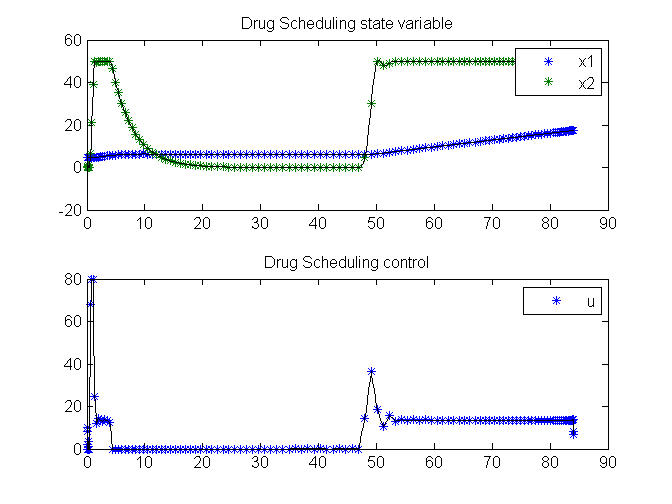PROPT Optimal Drug Scheduling for Cancer Chemotherapy
|
This page is part of the PROPT Manual. See PROPT Manual. |
Dynamic optimization of bioprocesses: efficient and robust numerical strategies 2003, Julio R. Banga, Eva Balsa-Cantro, Carmen G. Moles and Antonio A. Alonso
Case Study III: Optimal Drug Scheduling for Cancer Chemotherapy
Problem description
Many researches have devoted their efforts to determine whether current methods for drugs administration during cancer chemotherapy are optimal, and if alternative regimens should be considered. Martin (1992) considered the interesting problem of determining the optimal cancer drug scheduling to decrease the size of a malignant tumor as measured at some particular time in the future. The drug concentration must be kept below some level throughout the treatment period and the cumulative (toxic) effect of the drug must be kept below the ultimate tolerance level. Bojkov et al. (1993) and Luus et al. (1995) also studied this problem using direct search optimization. More recently, Carrasco and Banga (1997) have applied stochastic techniques to solve this problem, obtaining better results (Carrasco & Banga 1998). The mathematical statement of this dynamic optimization problem is: Find u(t) over t in [t0; t_f ] to maximize:
subject to:
where the tumor mass is given by N = 10^12 * exp (-x1) cells, x2 is the drug concentration in the body in drug units [D] and x3 is the cumulative effect of the drug. The parameters are taken as k1 = 9.9e-4 days, k2 = 8.4e-3 days-1 [De-1], k3 = 10 [De-1], and k4 = 0.27 days-1. The initial state considered is:
where,
H(x2-k3) = 1 if x2 >= k3 or 0 if x2 < k3
and the final time t_f = 84 days. The optimization is subject to the following constraints on the drug delivery (control variable):
There are the following path constraints on the state variables:
Also, there should be at least a 50% reduction in the size of the tumor every three weeks, so that the following point constraints must be considered:
State number 3 is converted to an integral constraints in the formulation.
% Copyright (c) 2007-2008 by Tomlab Optimization Inc.Problem setup
toms t
nn = [20 40 120];
for i = 1:length(nn)
n = nn(i);
p = tomPhase('p', t, 0, 84, n);
setPhase(p);
tomStates x1 x2
tomControls u
% Initial guess
if i==1
x0 = {icollocate(x2 == 10)
collocate(u == 20)};
else
x0 = {icollocate({x1 == x1opt; x2 == x2opt})
collocate(u == uopt)};
end
% Box constraints
cbox = {
0 <= mcollocate(x1)
0 <= mcollocate(x2) <= 50
0 <= collocate(u) <= 80};
% Boundary constraints
cbnd = initial({x1 == log(100); x2 == 0});
% ODEs and path constraints
k1 = 9.9e-4; k2 = 8.4e-3;
k3 = 10; k4 = 0.27;
ceq = {collocate({
dot(x1) == -k1*x1+k2*max(x2-k3,0)
dot(x2) == u-k4*x2})
% Point-wise conditions
atPoints([21;42;63],x1) >= log([200;400;800])
% Integral constr.
integrate(x2) == 2.1e3};
% Objective
objective = -final(x1);Solve the problem
options = struct;
options.name = 'Drug Scheduling';
options.solver = 'multiMin';
options.xInit = 130-n;
solution = ezsolve(objective, {cbox, cbnd, ceq}, x0, options);
x1opt = subs(x1, solution);
x2opt = subs(x2, solution);
uopt = subs(u, solution);Problem type appears to be: lpcon
Time for symbolic processing: 0.099354 seconds
Starting numeric solver
===== * * * =================================================================== * * *
TOMLAB - TOMLAB Development license 999007. Valid to 2011-12-31
=====================================================================================
Problem: --- 1: Drug Scheduling - Trial 26 f_k -17.121324912680684000
sum(|constr|) 0.000000000000627527
f(x_k) + sum(|constr|) -17.121324912680056000
Solver: multiMin with local solver snopt. EXIT=0. INFORM=0.
Find local optima using multistart local search
Did 110 local tries. Found 1 global, 98 minima. TotFuncEv 110. TotConstrEv 3078
FuncEv 110 ConstrEv 3078 ConJacEv 27 Iter 1392
CPU time: 2.246414 sec. Elapsed time: 2.418000 sec.
Problem type appears to be: lpcon
Time for symbolic processing: 0.10026 seconds
Starting numeric solver
===== * * * =================================================================== * * *
TOMLAB - TOMLAB Development license 999007. Valid to 2011-12-31
=====================================================================================
Problem: --- 1: Drug Scheduling - Trial 51 f_k -17.267378276475135000
sum(|constr|) 0.000000000002346713
f(x_k) + sum(|constr|) -17.267378276472787000
Solver: multiMin with local solver snopt. EXIT=0. INFORM=0.
Find local optima using multistart local search
Did 90 local tries. Found 1 global, 88 minima. TotFuncEv 90. TotConstrEv 3593
FuncEv 90 ConstrEv 3593 ConJacEv 24 Iter 1594
CPU time: 5.132433 sec. Elapsed time: 5.201000 sec.
Problem type appears to be: lpcon
Time for symbolic processing: 0.094742 seconds
Starting numeric solver
===== * * * =================================================================== * * *
TOMLAB - TOMLAB Development license 999007. Valid to 2011-12-31
=====================================================================================
Problem: --- 1: Drug Scheduling - Trial 6 f_k -17.407138702212308000
sum(|constr|) 0.000000000018677708
f(x_k) + sum(|constr|) -17.407138702193631000
Solver: multiMin with local solver snopt. EXIT=0. INFORM=0.
Find local optima using multistart local search
Did 10 local tries. Found 1 global, 10 minima. TotFuncEv 10. TotConstrEv 956
FuncEv 10 ConstrEv 956 ConJacEv 76 Iter 401
CPU time: 19.500125 sec. Elapsed time: 15.070000 sec.
endPlot result
subplot(2,1,1)
ezplot([x1;x2]);
legend('x1','x2');
title('Drug Scheduling state variable');
subplot(2,1,2)
ezplot(u);
legend('u');
title('Drug Scheduling control');



![{\displaystyle x(t_{0})=[log(100)\ 0\ 0]'}](https://wikimedia.org/api/rest_v1/media/math/render/svg/98d16eb5a58498b33edca33c1861b28d4ec35d7a)






